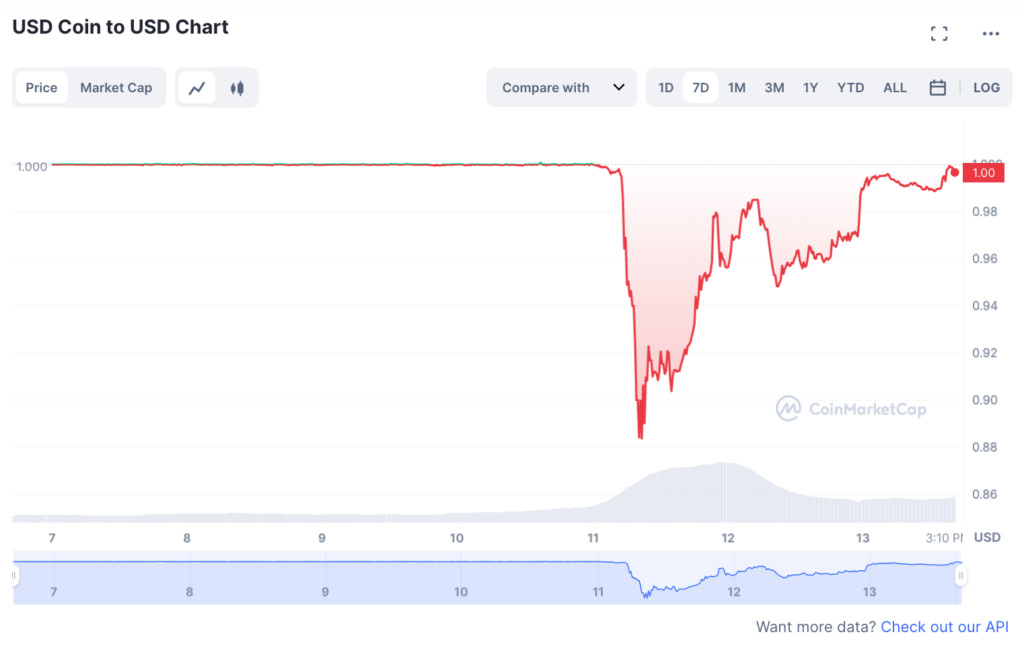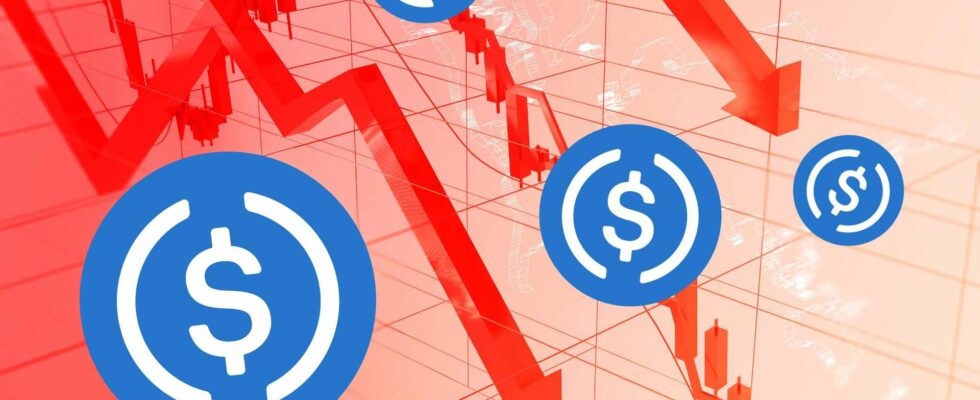The bankruptcy of SVB, the favorite bank of startups, could have repercussions in cryptocurrencies. This is what the upheavals around a stablecoin supposed, precisely, to be stable suggest. Its course fell, before recovering.
For a few hours, the cryptocurrency world held its breath on March 11: the USDC (or USD Coin), a stablecoin issued by the company Circle, lost its indexing. Ordinarily, the price of a token is tied to that of the dollar: 1 USDC is equal to 1 dollar, regardless of the value of the greenback. That the stablecoin will become misaligned by losing its indexation is therefore unlikely, but also a very bad omen.
It is this disaster scenario that played out on March 11, all because of the bankruptcy of a traditional bank, Silicon Valley Bank (or SVB), which at first glance seems far from the cryptocurrency sector. For now, Circle’s USDC seems to be off the hook. However, the story reawakened the trauma of the stablecoin Terra crash in 2022, and more importantly, raised the specter of a global financial crisis.
SVB, the startup bank
To better understand what happened to the USDC, we need to talk about SVB. Silicon Valley Bank is a classic bank, founded in 1983. Basically, it is not specifically geared towards companies in the cryptocurrency sector, unlike Silvergate, which very quickly specializes in the field. SVB is moving more towards tech startups, those that make Silicon Valley famous and famous around the world.
For the tech sector, the importance of this bank, which had become the 16th largest in the United States, is colossal. In 2020, it held more than $102 billion in assets, then doubled at the end of 2022. It has hosted a large number of startups that have now become benchmarks in their sector, such as Roblox, Roku, Trustpilot, BlockFi, and more than 2,500 venture capital firms, specializing in investments. These companies included Circle, which issues the USDC stablecoin.
A flash bankruptcy
Numerama has devoted an entire article to the history of SVB’s bankruptcy, which discusses all the technical and financial aspects in detail. But to have a more shortened version of the facts, here is what happened in summary.
Following the health crisis, the US central bank decided to raise its key rates, which had the effect of making it more difficult to borrow money. But for start-ups, it’s a problem when the business in which they operate cannot yet run on its own. As long as they are not profitable, they have to look for money.
SVB’s customers therefore continued to request the bank, but these requests became difficult to honor. To create room for manoeuvre, it must then sell, under unfavorable conditions, some of its investments, and also take out loans and sell some of its shares. Money out requests amount to 42 billion dollars.
This movement was amplified by rumors of the bank’s inability to return the sums on time. Inevitably, doubts around SVB’s future spread through Silicon Valley and calls began to plead for a withdrawal of deposits. This is the beginning of the bank panic, or bank run : everyone wants to withdraw their money simultaneously.
SVB then collapses and the future of all clients’ funds becomes very uncertain — this was true at least until the intervention of the American authorities, who declared to guarantee the deposits, in order to avoid re-triggering a financial crisis similar to the one that appeared at the end of the 2010s and whose symbol is the collapse of the bank Lehman Brothers.
How did the bankruptcy affect the USDC?
Bankruptcy therefore did not happen because of the crypto sector and the recent bankruptcy of the giant FTX, as it did for Silvergate, another American bank. However, the fall of SVB did have direct consequences on the sector, and in particular on a very important company in the sector: Circle.
Circle is in charge of issuing the USDC stablecoin. It is the second largest player by capitalization, behind Tether, with $40 billion. Overall, it is also the fourth cryptocurrency, just behind Binance’s BNB. It is a huge crypto. From then on, the loss of the indexation with the dollar triggered panic throughout the sector.
This indexation comes from a very simple mechanism: for each new token, 1 dollar equivalent is stored in Circle’s reserves, in the form of cash or with short-term US Treasury bonds. These reserves are kept in major financial institutions, such as BlackRock and BNY Mellon boasts Circle on its site. Except that part of Circle’s reserves were also stored at SVB. Bad luck.
What amounts are we talking about? According to company announcements on March 11, $3.3 billion was deposited with SVB, out of Circle’s $40 billion in reserves. Alerted by this message, some of Circle’s clients panicked resold their USDC, again following the same mechanism of bank run who had already brought down SVB.
The direct consequence of this massive sale of stablecoin is that the token loses its peg to the dollar, and the price drops. One USDC traded at $0.8837 on March 11 at 8:45 a.m., according to data from Coinmarketcap — at 10 p.m. the day before, it was still worth $1.
Is this the end of USDC?
A de-indexation is all the more serious for a stablecoin since a year ago, following another similar panic, the Terra token crashed and took with it a market capitalization of $50 billion. The still recent trauma of this bankruptcy certainly accelerated USDC withdrawals at the start of de-indexing. However, unlike Terra, the fall has stopped for the Circle stablecoin.

The worst seems to have been avoided for the moment thanks to several factors. First of all, several announcements from the American central bank came to reassure SVB customers, in particular the decision of the American Treasury to authorize access to deposits. ” Depositors will have access to all of their money from Monday, March 13. No loss related to the resolution of the SVB will be borne by the contributorthe,” said Janet Yellen, the Treasury Secretary.
Finally, the declaration of the CEO of Circle, Jeremy Allaire, on March 12, ended up allaying concerns. ” 100% of SVB deposits have been recovered and will be available when banks open tomorrow “, he tweeted.
Gradually, the value of the USDC has risen: at the time of writing this article, it is at 0.9989 dollars. So are the USDC’s troubles over? As always with cryptos, it remains difficult to say. In any case, Circle has managed not to replicate the Terra Crash, and not further destabilize the cryptocurrency industry — yet.
If you liked this article, you will like the following ones: do not miss them by subscribing to Numerama on Google News.
